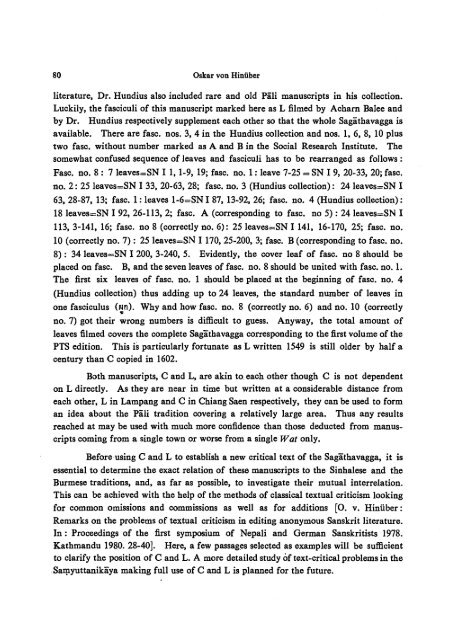The Journal of the Siam Society Vol. LXXI, Part 1-2, 1983 - Khamkoo
The Journal of the Siam Society Vol. LXXI, Part 1-2, 1983 - Khamkoo
The Journal of the Siam Society Vol. LXXI, Part 1-2, 1983 - Khamkoo
You also want an ePaper? Increase the reach of your titles
YUMPU automatically turns print PDFs into web optimized ePapers that Google loves.
80 Oskar von Hiniiber<br />
literature, Dr. Hundius also included rare and old Pili manuscripts in his collection.<br />
Luckily, <strong>the</strong> fasciculi <strong>of</strong> this manuscript marked here as L filmed by Acham Balee and<br />
by Dr. Hundius respectively supplement each o<strong>the</strong>r so that <strong>the</strong> whole Sagathavagga is<br />
available. <strong>The</strong>re are fasc. nos. 3, 4 in <strong>the</strong> Hundius collection and nos. 1, 6, 8, 10 plus<br />
two fasc. without number marked as A and B in <strong>the</strong> Social Research Institute. <strong>The</strong><br />
somewhat confused sequence <strong>of</strong> leaves and fasciculi has to be rearranged as follows:<br />
Fasc. no. 8 : 7 leaves=SN I 1, 1-9, 19; fasc. no. 1: leave 7-25 = SN I 9, 20-33, 20; fasc.<br />
no. 2: 25 leaves=SN I 33, 20-63, 28; fasc. no. 3 (Hundius collection) : 24 leaves=SN I<br />
63, 28-87, 13; fasc. 1: leaves 1-6=SN I 87, 13-92, 26; fasc. no. 4 (Hundius collection):<br />
18 leaves=SN I 92, 26-113, 2; fasc. A (corresponding to fasc. no 5) : 24 leaves=SN I<br />
113, 3-141, 16; fasc. no 8 (correctly no. 6): 25leaves=SN I 141, 16-170, 25; fasc. no.<br />
10 (correctly no. 7): 25 leaves=SN I 170, 25-200, 3; fasc. B (corresponding to fasc. no.<br />
8): 34leaves=SN I 200, 3-240, 5. Evidently, <strong>the</strong> cover leaf <strong>of</strong> fasc. no 8 should be<br />
placed on fasc. B, and <strong>the</strong> seven leaves <strong>of</strong> fasc. no. 8 should be united with fasc. no. 1.<br />
<strong>The</strong> first six leaves <strong>of</strong> fasc. no. 1 should be placed at <strong>the</strong> beginning <strong>of</strong> fasc. no. 4<br />
(Hundius collection) thus adding up to 24 leaves, <strong>the</strong> standard number <strong>of</strong> leaves in<br />
..<br />
one fasciculus (Nn). Why and how fasc. no. 8 (correctly no. 6) and no. 10 (correctly<br />
no. 7) got <strong>the</strong>ir wrong numbers is difficult to guess. Anyway, <strong>the</strong> total amount <strong>of</strong><br />
leaves filmed covers <strong>the</strong> complete Sagathavagga corresponding to <strong>the</strong> first volume <strong>of</strong> <strong>the</strong><br />
PTS edition. This is particularly fortunate as L written 1549 is still older by half a<br />
century than C copied in 1602.<br />
Both manuscripts, C and L, are akin to each o<strong>the</strong>r though C is not dependent<br />
on L directly. As <strong>the</strong>y are near in time but written at a considerable distance from<br />
each o<strong>the</strong>r, L in Lampang and C in Chiang Saen respectively, <strong>the</strong>y can be used to form<br />
an idea about <strong>the</strong> Pali tradition covering a relatively large area. Thus any results<br />
reached at may be used with much more confidence than those deducted from manuscripts<br />
coming from a single town or worse from a single Wat only.<br />
Before using C and L to establish a new critical text <strong>of</strong> <strong>the</strong> Sagathavagga, it is<br />
essential to determine <strong>the</strong> exact relation <strong>of</strong> <strong>the</strong>se manuscripts to <strong>the</strong> Sinhalese and <strong>the</strong><br />
Burmese traditions, and, as far as possible, to investigate <strong>the</strong>ir mutual interrelation.<br />
This can be achieved with <strong>the</strong> help <strong>of</strong> <strong>the</strong> methods <strong>of</strong> classical textual criticism looking<br />
for common omissions and commissions as well as for additions [0. v. Hiniiber:<br />
Remarks on <strong>the</strong> problems <strong>of</strong> textual criticism in editing anonymous Sanskrit literature.<br />
In: Proceedings <strong>of</strong> <strong>the</strong> first symposium <strong>of</strong> Nepali and German Sanskritists 1978.<br />
Kathmandu 1980. 28-40]. Here, a few passages selected as examples will be sufficient<br />
to clarify <strong>the</strong> position <strong>of</strong> C and L. A more detailed study <strong>of</strong> text-critical problems in <strong>the</strong><br />
Sarpyuttanikiya making full use <strong>of</strong> C and L is planned for <strong>the</strong> future.

















